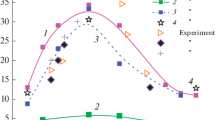Abstract
The reasons for formation of superequilibrium concentrations of radicals are studied by means of joint consideration of experimental data on the distributions of CH and OH molecules formed during diffusion combustion of ethanol and data on heat transfer in the chemical reaction region. The air flow velocity near the stagnation point in experiments with combustion is 0.7 m/sec, and the flow velocity along a flat plate is 10 m/sec (the turbulence levels are 1 and 18%). Mutual locations of specific features in the distributions of the heat-release rate and temperature are analyzed and compared with the distributions of OH and CH radicals. For all turbulence levels and flow velocities considered, the maximum concentration of radicals is reached on the boundaries of the heat-release region, whose locations are determined by molecular transport mechanisms. It is demonstrated that this conclusion is applicable to experimental data on diffusion combustion of a submerged hydrogen jet in air.
Similar content being viewed by others
References
H. N. Najm, P. H. Paul, C. J. Mueller, and P. S. Wickoff, “On the adequacy of certain experimental observables as measurements of flame burning rate,” Combust. Flame, 113, 312–332 (1998).
J. M. Seitzman, A. Ungut, P. H. Paul, and R. K. Hanson, “Imaging and characterization of OH structures in a turbulent nonpremixed flame,” in: Proc. 23rd Symp. (Int.) on Combustion, The Combustion Inst., Pittsburgh (1990), pp. 637–644.
R. K. Hanson, J. M. Seitzman, and R. H. Paul, “Planar laser-fluorescence imaging in combustion gases,” Appl. Phys. B, No. 50, 441–454 (1990).
D. Han and M. G. Mungal, “Simultaneous measurements of velocity and CH distributions. Part 1: Jet flames in co-flow,” Combust. Flame, 132, 565–590 (2003).
J. M. Donbar, J. F. Driscoll, and C. D. Carter, “Reaction zone structure in turbulent nonpremixed jet flames — from OH-CH PLIF images,” Combust. Flame, 122, 1–19 (2000).
Puri, Moser, Santoro, and Smyth, “Laser-induced fluorescence measurements of OH-concentrations in the oxidation region of laminar, hydrocarbon diffusion flames,” in: Proc. 24th Symp. (Int.) on Combustion, The Combustion Inst., Pittsburgh (1992), pp. 1015–1022.
J. E. Rehm and N. T. Clemens, “The relationship between vorticity/strain and reaction zone structure in turbulent non-premixed jet flame,” in: Proc. 27th Symp. (Int.) on Combustion, The Combustion Inst., Pittsburgh (1998), pp. 1113–1120.
H. Pitsch and H. Steiner, “Large eddy simulation of turbulent piloted methane/air diffusion flame (Sandia flame D),” Phys. Fluids, 12, No. 10, 2541–2554 (2000).
C. J. Sung, J. B. Liu, and C. K. Law, “Structural response of counter flow diffusion flames to strain rate variations,” Combust. Flame, 102, 481–492 (1995).
M. C. Drake, R. W. Pitz, M. Lapp, C. P. Fenimore, R. P. Lucht, D. W. Sweeney, and N. M. Laurendeau, “Measurements of superequilibrium hydroxyl concentrations in turbulent nonpremixed flames using saturated fluorescence,” in: Proc. 20th Int. Symp. on Combustion, The Combustion Inst., Pittsburgh (1984), pp. 327–335.
B. F. Boyarshinov, V. I. Titkov, and S. Yu. Fedorov, “Distribution of OH and CH radicals in the boundary layer with ethanol combustion,” Combust., Expl., Shock Waves, 41, No. 4, 379–385 (2005).
B. F. Boyarshinov and S. Yu. Fedorov, “Measurement of temperature and concentration of OH radicals in combustion of hydrogen and ethanol by the laser-induced fluorescence technique,” Combust., Expl., Shock Waves, 40, No. 5, 511–515 (2004).
B. F. Boyarshinov, É. P. Volchkov, V. I. Terekhov, and S. A. Shutov, “Turbulent boundary layer with the injection of reactive materials,” Combust., Expl., Shock Waves, 17, No. 6, 601–606 (1981).
B. F. Boyarshinov, É. P. Volchkov, and V. I. Terekhov, “Structure of a boundary layer with injection and combustion of ethanol,” Combust., Expl., Shock Waves, 28, No. 3, 235–241 (1992).
B. F. Boyarshinov, “Boundary layer with large eddies, including evaporation and combustion,” Doct. Dissertation in Tech. Sci., Novosibirsk (2007).
B. F. Boyarshinov and V. I. Titkov, “Effect of free-stream turbulence on the boundary-layer structure with diffusion combustion of ethanol,” J. Appl. Mech. Tech. Phys., 42, No. 6, 972–978 (2001).
P. Libby and F. Williams (eds.), Turbulent Reacting Flows, Springer, Heidelberg (1980).
I. A. Davletshin, D. V. Kratirov, S. M. Mekeshkin, N. I. Miheev, V. M. Molochnikov, and K. R. Hayrnasov, “New hot-wire and thermometric apparatus,” in: Proc. of the 13th Int. Conf. on Methods of Aerophysical Research (Novosibirsk, Russia, February 5–10, 2007), Part III, Parallel, Novosibirsk (2007), pp. 70–74.
S. I. Isaev, I. A. Kozhinov, et al., Theory of Heat and Mass Transfer [in Russian], Vysshaya Shkola, Moscow (1979).
D. Bradly, “How fast can we burn?” in: Proc. 24th Symp. (Int.) on Combustion, The Combustion Inst., Pittsburgh (1992), pp. 247–262.
J. A. Wehrmeyer, S. Yeralan, and K. S. Tecu, “Influence of strain rate and fuel dilution on laminar nonpremixed hydrogen-air flame structure: An experimental investigation,” Combust. Flame, 107, 125–140 (1996).
R. P. Lucht, D. W. Sweeney, N. M. Laurendeau, M. C. Drake, M. Lapp, and R. W. Pitz, “Single-pulse, laser-saturated measurements of OH in turbulent nonpremixed flames,” Optics Lett., 9, No. 3, 90–92 (1984).
Author information
Authors and Affiliations
Corresponding author
Additional information
__________
Translated from Fizika Goreniya i Vzryva, Vol. 44, No. 6, pp. 3–11, November–December, 2008.
Rights and permissions
About this article
Cite this article
Boyarshinov, B.F. Effect of heat transfer on the distributions of OH and CH radicals in the boundary layer with ethanol combustion. Combust Explos Shock Waves 44, 619–626 (2008). https://doi.org/10.1007/s10573-008-0095-9
Received:
Revised:
Published:
Issue Date:
DOI: https://doi.org/10.1007/s10573-008-0095-9



